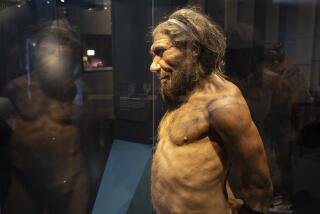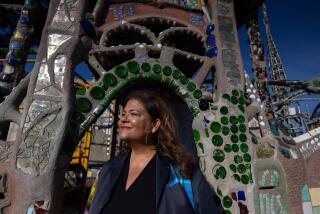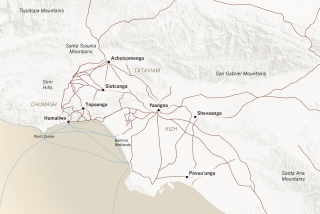BOOK REVIEW / HISTORY : A Celebration of Diversity in America’s Prehistory : HIDDEN CITIES: The Discovery and Loss of Ancient North American Civilization <i> by Roger G. Kennedy</i> ; Free Press $24.95, 372 pages
At odd moments, Roger Kennedy’s “Hidden Cities” seems almost like a science-fiction novel--we find ourselves in a parallel universe in which North America is populated by lost tribes whose vast sacred architecture rivals that of the Mayas or the Egyptians.
But the landscape that Kennedy describes so startlingly is a very real place, and the men and women who lived upon it include some of the most familiar figures of American history.
Kennedy’s book is an account of the long-overlooked and sometimes overtly suppressed prehistory of North America--and the influence of that prehistory on the earliest founders of the United States and the politics of the infant democracy.
The focus of “Hidden Cities” is the monumental architecture that the explorers and settlers of North America discovered as they carried out their self-appointed task of nation-building in the New World. Not only did they encounter the native dwellers of the “new” continent, but also evidence of a far older civilization that had disappeared long before.
“In the countryside there were hundreds of thousands of earthen reminders of prior habitation; there still are tens of thousands,” writes Kennedy, former director of the American History Museum at the Smithsonian and now director of the National Park Service.
“The shock of these discoveries forced upon the founders the possibility that Indians were not all savages.”
What they found--and what Kennedy describes in “Hidden Cities”--is a series of complex earthen constructions, the eroded remnants of mounds and cones and rings that were once the grand architecture of an ancient civilization.
The complex of temples and palaces at Cahokia, Ill., include the remains of a pyramid that was greater in extent than the Egyptian one at Giza. The Serpent Mound of the Hopewell Indians in the Ohio Valley is thought to record the same comet that appears in the 11th-Century Bayeaux Tapestry.
The very fact that North America has a prehistory will come as a surprise to many of Kennedy’s readers. He reveals that the sacred architecture was the handiwork of peoples who disappeared in what historians call “the Great Dying,” an imported plague that claimed about 30 million lives “in the first century after the invasion of the microbes and the (16th-Century) conquistadors.”
Kennedy makes room in his book for a discussion of the grand achievement and the sorry fate of the victims of the Great Dying. Still, much of Kennedy’s attention is directed toward the impressions that these discoveries made on the leaders of the infant American democracy.
We learn, for example, that George Washington happened upon the ancient architecture of North America during the various “real-estate campaigns” that made him a wealthy land baron, and Thomas Jefferson may have patterned his house at Poplar Forest upon the geometric patterns of the sacred mounds of the Adena and Hopewell cultures.
But Kennedy is not merely trading upon the curiosity value of architectural antiquities. Rather, he suggests that some enlightened and committed souls among the founders--including, notably, men such as Secretary of the Treasury Albert Gallatin, a political ally of Jefferson--were able to envision a Manifest Destiny in which all people of North America might share.
“(Gallatin) was convinced that each of the races and nations coming together in that great crucible might generate mutual respect out of a due appreciation of the past achievements of each,” Kennedy writes of Gallatin’s entry into the archeologically rich Ohio Valley in the late 1780s. “The architecture found in the valley was evidence of the achievement of the Indians.”
As Kennedy reveals in meticulous but sometimes moving detail, the high hopes of a figure such as Gallatin were extinguished in the furnace of American politics. Washington himself might engage in a gesture of accommodation when addressing a message to the Cherokee--he crossed out the word God and replaced it with the Great Spirit Above out of concern for their religious sensibilities--but Jefferson conceded the West to plantation-style slavery and the Native Americans were doomed to life on the reservation and worse.
Meanwhile, Kennedy reveals, solid historical evidence was ignored--or even suppressed--by plucky imperialists for whom evidence of Native American cultural achievement was inconvenient. That’s why, Kennedy explains, some Americans (including Jefferson) subscribed to a curious theory “that the mounds were built by pink-skinned people who had arrived during the Middle Ages from Wales.”
“It followed that Native American religious art was relegated to the trash heap,” Kennedy writes, “and even scientific interest in ‘savage’ architecture abated among the orthodox.”
Kennedy might be surprised to hear it, but I came away from his book with the sense that “Hidden Cities” is the very highest expression of multiculturalism in the study of American history.
Kennedy resurrects and honors the cultural achievements of the very first Americans; he writes with real candor about the “dead white males” who struggled to make sense of what they saw in these remarkable constructions, and he thereby celebrates the remarkable diversity--there is no better word for it--that reveals itself in the tapestry of American civilization.
More to Read
The biggest entertainment stories
Get our big stories about Hollywood, film, television, music, arts, culture and more right in your inbox as soon as they publish.
You may occasionally receive promotional content from the Los Angeles Times.










